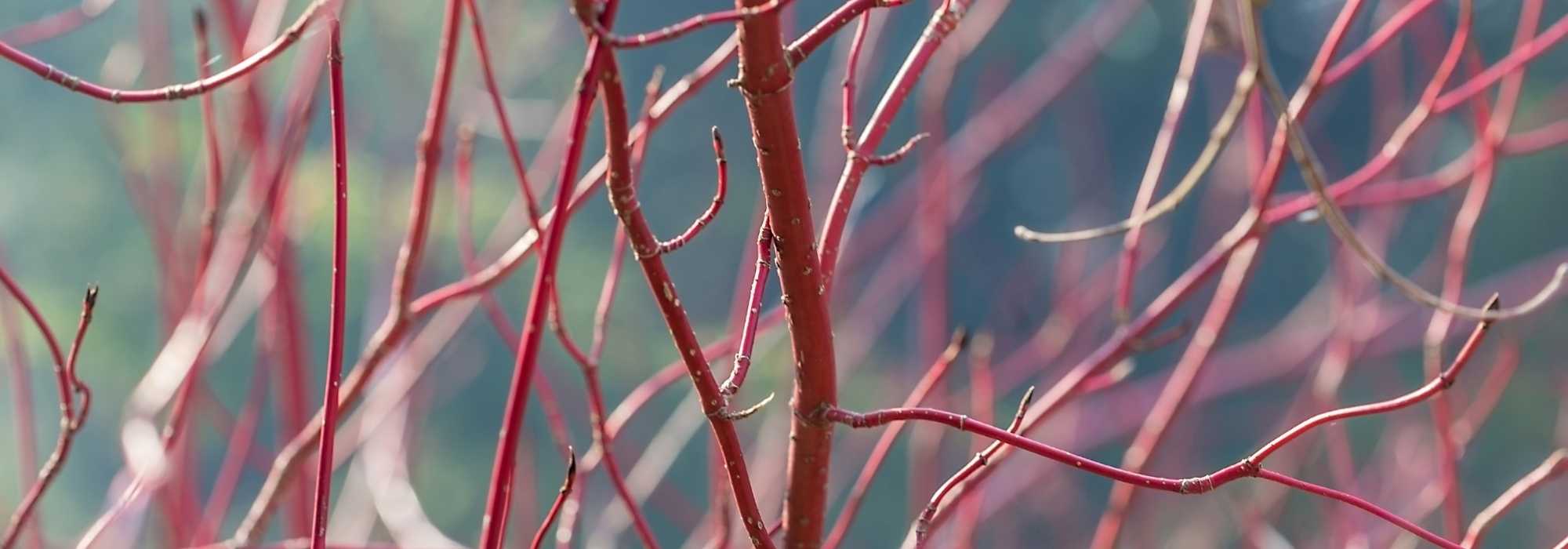
The Winter garden
When the garden takes up its winter quarters
Contents
Since a certain French best-seller in 2016 and a trend that originated in England, we no longer view our gardens the same way in winter. For winter, this “reinvented” season as Cedric Pollet described, has become trendy for our gardens. While autumn enhances the foliage, winter indeed brings poetry and magic to the sleeping nature: it reveals the barks, brings the grasses back into the light, magnifies the conifers, colours some bushes in parchment-like or even fluorescent hues, dazzles us with blooms and fruits, all more graceful than the last… And when frost and snow appear and cover the plants, the garden transforms into a fairy-tale tableau!
Is winter a troublesome season? Far from it… this is what many gardeners and landscapers have understood by increasingly incorporating this winter ornamental dimension into the garden. Join us for an enchanted interlude in the Winter garden!
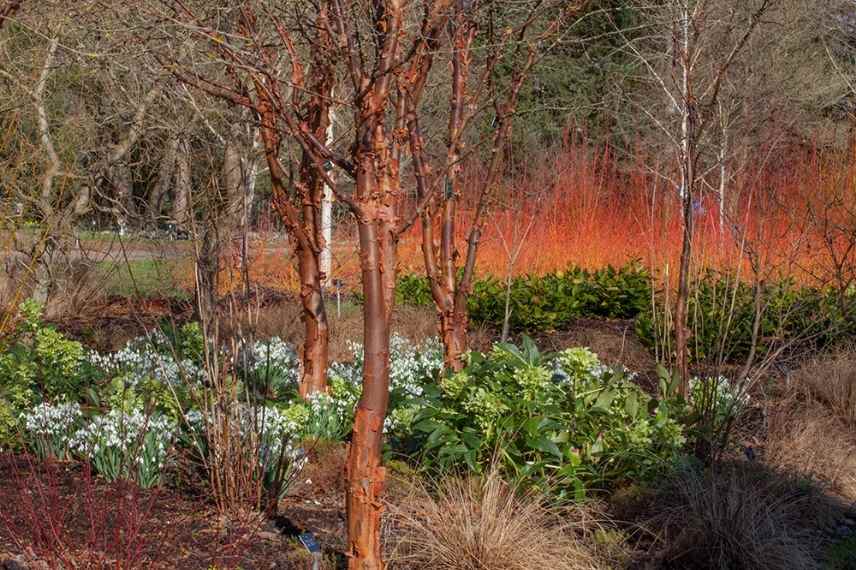
The winter garden invites us to look at nature with a different eye, one we might tend to abandon during the dreary season. Here, a lovely scene at the Sir Harold Hillier Gardens in England (© Marc Pringle)
What is a winter garden?
When we talk about a winter garden, we generally think of a decorative room, those beautiful conservatories or old greenhouses often open to a part of the house, useful for wintering some lovely tender exotics.
However, this term is increasingly used to refer to what interests us in this article (…even if the other winter garden is charming): an attractive garden that plays on winter colours during the dreary season. Originating from England, this winter garden, which relies on the infinite resources of the plant palette, emerged in the 1980s. There, many gardens remain open during the cold season, and “winter walks”—these winter strolls revealing the most beautiful colourful specimens—are even highly sought after by the English.
Now a trend in Europe, this type of garden indeed aims to breathe life into the garden in winter, based on the chromatic potential of many plants that have perhaps not been used enough until now, by exploiting evergreen foliage, bark, bare habits, flowering and berries, as well as leaving faded plants in place.
While winter flowering plants, often long-lasting like Hamamelis, hellebores, or Daphnes, are part of the mix, the winter garden relies on certain essential plants—conifers, birches or prunus, heathers, and grasses—and others to be gathered from the most beautiful wood shrubs, winter flowers or fruiting plants. The winter garden then successfully achieves the bold challenge of infusing sublime colours and incredible structure into the garden during the months considered the most dreary.

Colour games brought by the bark of birches (bottom centre Betula ermanii), the reddened wood of dogwoods, berries, long-lasting flowers like hellebores, and bright hues like those of Mahonias
Read also
Designing a four-season gardenThe main principles of composition
To ensure that the winter garden functions well and creates that poetic and graceful atmosphere, it’s important to focus on certain essentials in landscaping. We no longer rely solely on heather, long considered the only ornamental plant for winter, but rather on several types of plants that will harmonise perfectly from a graphic, chromatic, and volumetric perspective:
- Some evergreen foliage for visual structure and volume, often rhythmically complemented by conifers, as well as spindle trees, skimmias, boxwood, rhododendrons, Ophiopogons, and Hakonechloas, etc.
- Remarkable barks and woods that punctuate the garden, offering vertical lines and effects of colour, shine, or texture with exfoliating barks and delicate branches: the kings Betulas, Prunus, and Acers, the divine cornus and rubus…
- Silhouettes of interest: stripped bare for long months, we favour deciduous trees with spreading habits (such as Acer palmatum or paper tree, for example), tiered (like Cornus controversa) or in coppice, resembling winter sculptures, and we opt for a few weeping or umbrella-shaped shrubs or trees, or twisted branches like Corylus avellana ‘Contorta’ or Poncirus trifoliata.
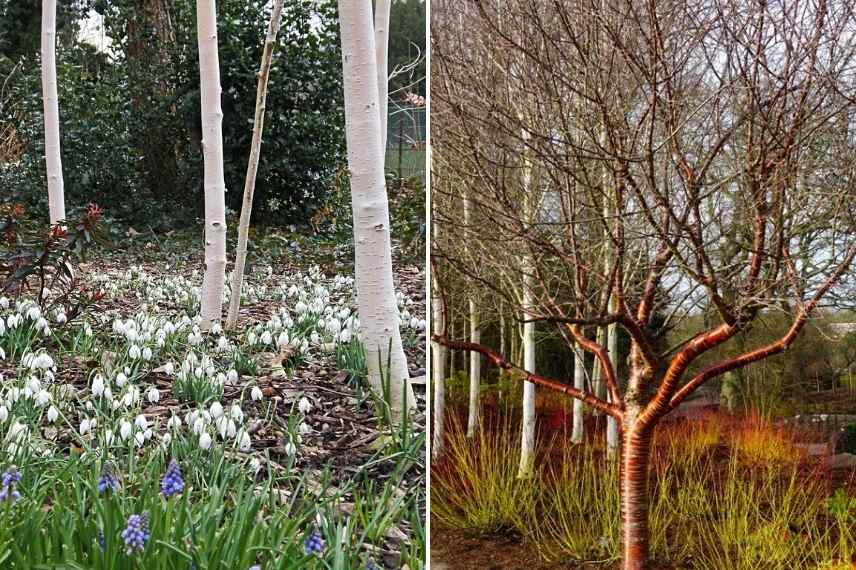
The white barks of Himalayan birches and a festival of snowdrops and muscari in the winter walk at Ragley Hall in England (© Amanda Slater). To the right, the beautiful contrast between the silhouette of a Tibetan cherry tree, yellow cornus, and a grove of birches.
- Delicate winter blooms to awaken the cooler hues. As groundcover or in tree form, they simply support the overall display of foliage, barks, and colourful woods.

Among the wide range of winter blooms: snowdrops, Bodnantense viburnum, hellebores, Hamamelis, and winter heather.
- Areas designed and studied through colour play: soothing colour gradations or, conversely, contrasts between warm and cool colours are both effective in enhancing and energising the plants.
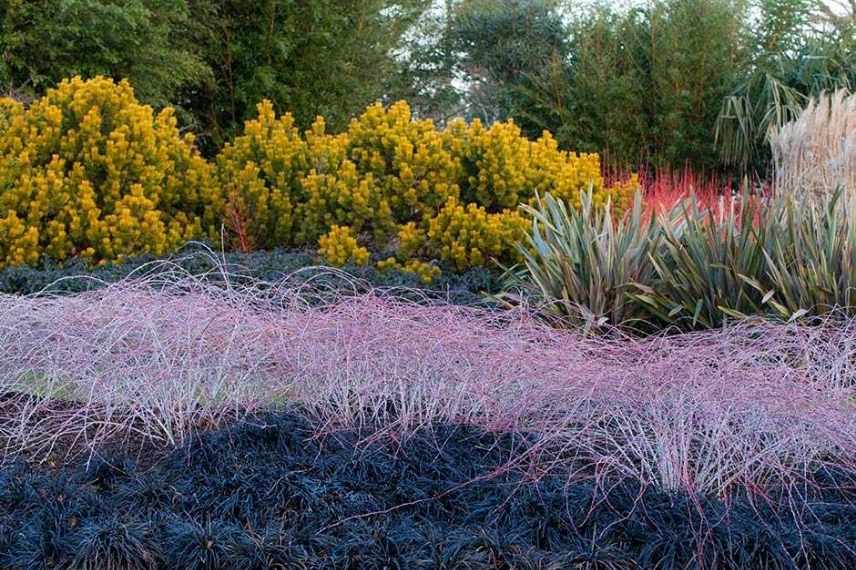
Strong and contrasting colours at Sir Harold Hillier Garden: Ophiopogons planiscapus ‘Nigrescens’, Rubus cockburnianus, Phormiums, Cornus, grasses, and golden pines.
- Plants that perform well in other seasons through bulbous and perennial plants with spring or summer blooms, and thanks to quality 2-in-1 plants that shine in at least two seasons.
- A subtle mix and beautiful harmony of all these components, to create visually soft and photogenic scenes!
A fairy tale of colours
Because it plays with colours, the winter garden invites us to revisit our chromatic alphabet and the (many!) plants with winter interest. We will mix in the still-present foliage, often dark green, variegated with bluish tones in winter, with a rich colour palette. Flowering is ultimately just one of the tools to use, allowing for a beautiful transition to spring.
- vibrant tones: undoubtedly the most used, they range from orange to mahogany red… These are the warm colours par excellence, essential for the winter garden. They are brought about either by naked wood (the Cornus are the most vibrant example, but also Salix purpurea or the coppery tones of Salix alba ‘Vitellina’), the sublime cinnamon to mahogany bark of Acers and Prunus (among them Acer griseum, Prunus serrula, Prunus maackii, Betula gynoterminallis) and some foliage reddening in the cold (Bergenias, azaleas, sacred bamboos, etc.), or by bright flowers (Hamamelis). Not to mention the countless winter fruiting plants that redden (ornamental apple trees, Cotoneasters, holly, some Berberis, Pyracanthas, Persimmons, Nandinas domestica, Physalis, the hips…).
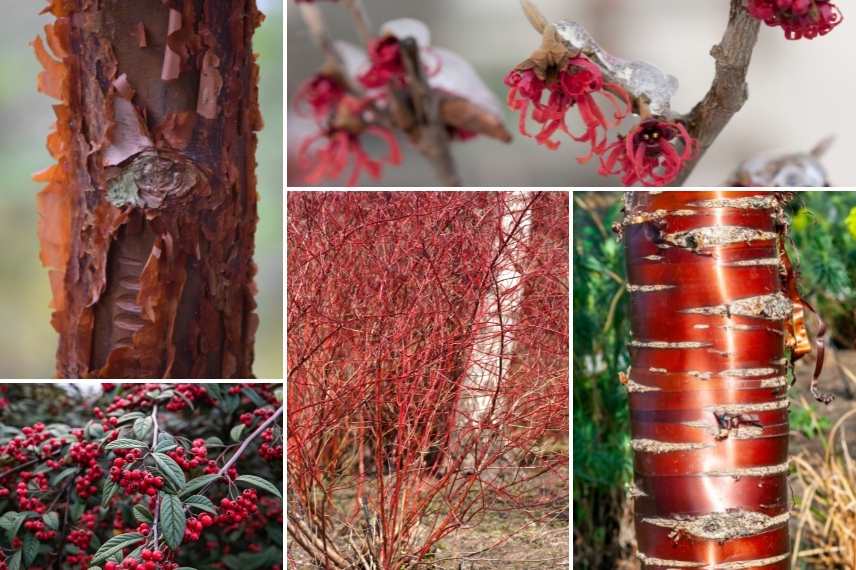 Bark of Acer griseum, Hamamelis, Cotoneaster, Cornus alba and the bark of Prunus serula
Bark of Acer griseum, Hamamelis, Cotoneaster, Cornus alba and the bark of Prunus serula
- yellow to orange tones: they emerge on the bare wood of Cornus sericea or flaviramea, from Salix erythroflexuosa, but also of course the winter flowers that bring a lot of brightness to the garden and combine with the vibrant tones, creating beautiful colour gradients: Edgeworthia chrysantha, Chimonanthus praecox, Mahonias, Hamamelis, Cornus mas, Corylopsis…
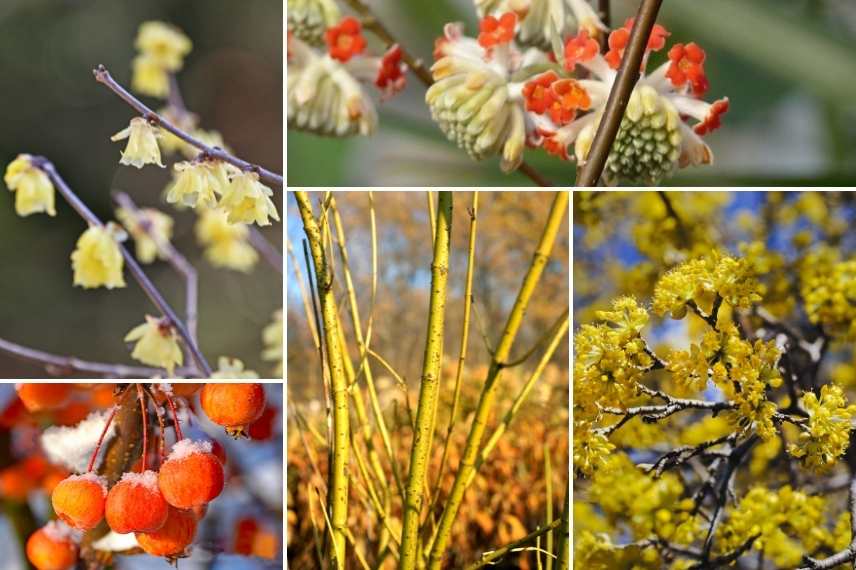 Chimonanthus praecox, Malus evereste, Edgeworthia chrysantha ‘Red Dragon’, Cornus sericea flaviramea, and Cornus mas
Chimonanthus praecox, Malus evereste, Edgeworthia chrysantha ‘Red Dragon’, Cornus sericea flaviramea, and Cornus mas
- pink to purple tones: the winter viburnums (V. Bodnantense), Daphnes, heathers (Erica carnea, Erica darleyensis), early Prunus, Chaenomeles, some oriental hellebores, Camellias, Cercis at the end of winter, up to the delicious violet of Callicarpas, to the bare branches of Salix purpurea, etc.
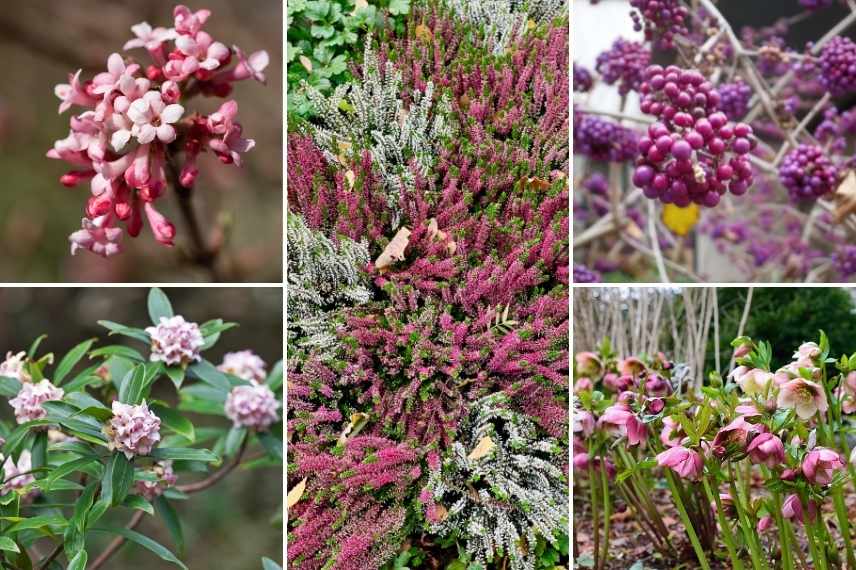 Viburnum bodnantense, Daphne, Erica darleyensis, Callicarpa and Hellebores
Viburnum bodnantense, Daphne, Erica darleyensis, Callicarpa and Hellebores
- green and bluish tones: Pines, Juniperus, Chamaecyparis and many conifers, eucalyptus, lavenders, cinerarias, santolines, muscaris, certain grasses including the fabulous fescues: the bluish tones are colour enhancers for the winter garden. Evergreen, they are mainly used in sunny spots and often have interesting cushion shapes in low strata. Don’t forget them to create stunning contrasts with pink, orange, or darker shades! The green tones are brought by several deciduous species including spindle trees, boxwoods, holly, and of course conifers, often chosen in bright, almost tangy tones.
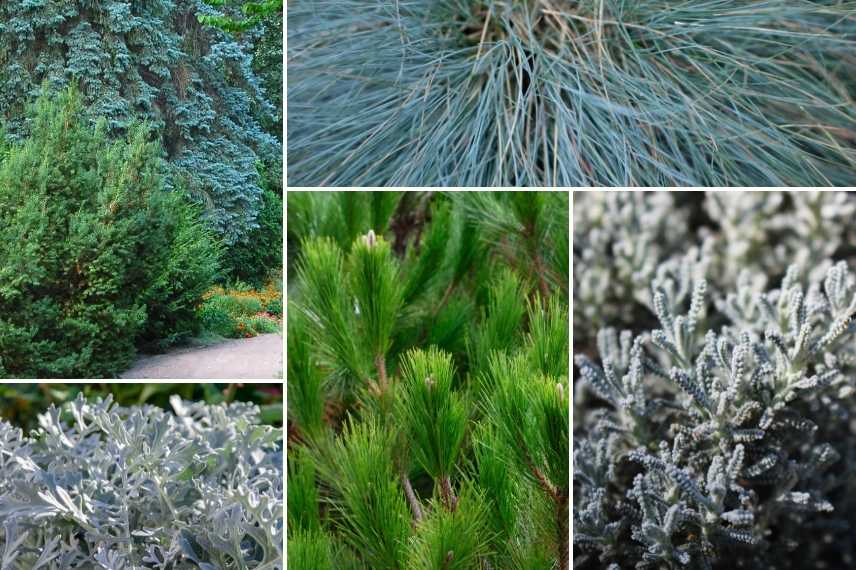 Cedars, chamaecyparus, pines, but also fescues, cinerarias and santolines which create remarkable tufts contrasting with the volumes provided by the larger trees
Cedars, chamaecyparus, pines, but also fescues, cinerarias and santolines which create remarkable tufts contrasting with the volumes provided by the larger trees
- white to silver touches: these are the immaculate flowers suggesting snow, bringing a lot of softness to the beds. We can count on a wide range of winter heathers (Ericas), hellebores, symphorine, snowdrops and wood anemones, Sarcococca, and many barks or woods: Betulas, Rubus biflorus, Rubus cockburnianus…. But also Garrya eliptica, the catkins of willows like Salix caprea… and to welcome spring, the whiteness of Magnolias stellata.
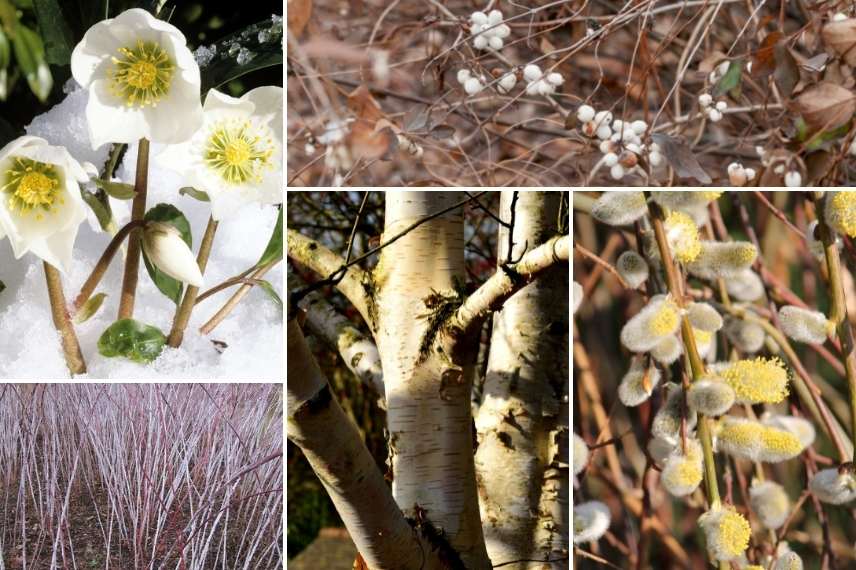 Helleborus niger, Symphoricarpos, Rubus cockburnianus (© Leonora Enking), Betula utilis Jacquemontii and Salix caprea
Helleborus niger, Symphoricarpos, Rubus cockburnianus (© Leonora Enking), Betula utilis Jacquemontii and Salix caprea
- parchment-like tones, rusty straw: these are mainly the grasses and faded inflorescences that remain in place, as well as the marcescent trees and the russet ferns, just as remarkable as the brighter shades, as they harmonise perfectly with the ambient softness created by the cold. These faded tones confer infinite grace and much cohesion between the different subjects planted in a large bed.
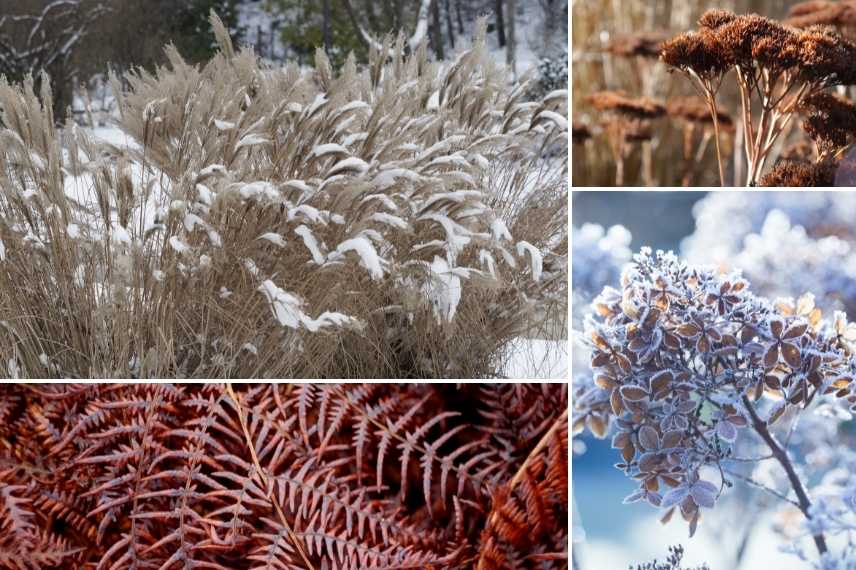 Beige tones of Miscanthus and russet ferns, preserved inflorescences of Sedums and Hydrangeas: all add to the muted grace of the winter garden
Beige tones of Miscanthus and russet ferns, preserved inflorescences of Sedums and Hydrangeas: all add to the muted grace of the winter garden
Read also
The most beautiful barksGames of textures
Primarily brought to life by conifers, evergreen trees and bushes, as well as the bark of deciduous trees, textures take centre stage in a winter garden. Beyond colours, they offer a range of softness (the velvety leaves of Lavandula lanata or Stachys in mild climates), shine (the smooth bark of Prunus or Acer davidii, the reddening of berries), dullness from the exfoliation of birches, the wood of Rubus, ethereal sensations (airy grasses, Salix caprea), and striking visuals or substantial volume (heathers, hellebores, or Cornus in mass)… The winter adornment would truly be different in a winter garden without a skillful mix of these shapes and densities of diverse foliage.
 The winter walk at Savill Garden: Hachonekloas, hellebores, ivy, Cornus Winter Flame, and birches. Textures are also found in certain lavenders, all conifers, and Prunus.
The winter walk at Savill Garden: Hachonekloas, hellebores, ivy, Cornus Winter Flame, and birches. Textures are also found in certain lavenders, all conifers, and Prunus.
→ Read also: Which evergreen bushes for a colourful winter?
A winter garden... that adapts
If the winter garden seems complicated to design at first glance, it is likely due to the species it comprises—bark trees like birches and prunus, conifers—that require a few years to fully express their potential. The winter garden can truly be envisioned in many spaces, taking care to adapt it according to dimensions, exposures, and soil type.
- More at home in large gardens or parks, with a few plants planted en masse, it is indeed grand in spaces where one can step back to admire it. However, the winter garden can also be declinated in smaller gardens: in this case, you would choose a single bed where you highlight 3 or 4 ornamental plants, including a tree or bush, with a fastigiate or rounded habit, for example. Generally, plant more in mass than in diversity.

Savill Garden in England (© Karen Roe): winter gardens are enhanced in large spaces
- The gardens in the south of France will certainly feature species more suited to the climate and soil, well-resistant to drought and possessing the ornamental qualities of the winter garden: the Arbutus unedo and Eucalyptus for their persistence and beautiful bark, for example, as well as bamboos, Euphorbias, etc.
- Many winter gardens are enhanced in very sunny exposures, a condition required by conifers, heathers, or grasses. However, most of the flagship plants of this type of garden can tolerate light partial shade, such as prunus and birches, dogwoods, while shade allows for beautiful beds with hellebores and daphnes. Therefore, all gardens can aspire to a winter garden!
- Acidic soil often suits well as it is adapted to many evergreens like heather soil shrubs or conifers, but again, a wide range of plants tolerant of lime can also find a place in the winter garden (stinking or Corsican hellebores, Euphorbias, Erica mediterranea…)
Essential Winter gardens in France and Europe
Some gardens have made a name for themselves with their winter decor, and it is during the shortest hours of the year that one must discover them to be convinced of their ornamental interest throughout the four seasons… Several gardens in France and Belgium are open all year round, and of course, many gardens across the Channel:
- In France: including the Jardin du Bois Marquis near Vienne, and Princess Greta Sturzda’s garden ‘Le Vasterival’ in Varengeville-sur-mer, near Dieppe.
- In Belgium: the Kalmthout Arboretum with its remarkable collection of Hamamelis, the crystal garden Fleurissart in Bousval…
- In England, there are many worth visiting: Sir Harold Hillier Gardens in Hampshire to the south; Anglesey Abbey near the city of Cambridge in the east; Savill Garden not far from London (part of the Windsor gardens); Bressingham Gardens in Norfolk, one of the oldest, Rosemoor Gardens to the south in Devon, Bodnant Gardens in Wales, Wisley Gardens in Surrey, and the stunning Cambridge University Botanic Garden…

Ragley Hall (© Amanda Slater): Cornus, Ophiopogons and snowdrops, Anglesey Abbey gardens (© sps 1955): Cornus, Hamamelis, variegated euonymus and Viburnum bodnantense
Readings for inspiration
When some gardens are a bit too far to visit, there are always books… and what books! All more beautiful than the last, here are those that should convince you of the usefulness of inviting winter into the garden:
- Winter garden: Reinventing the season by Cédric Pollet. 2016. Ed. Ulmer.
- Bark: A Journey into the Intimacy of Trees Around the World by Cédric Pollet. 2008. Ed. Ulmer
- My Garden in Winter by Snezana Gerbault. 2018. Ed. Delachaux et Niestlé
- All the Beautiful Plants in Winter by James Garnett and Didier Willery. 2019. Ed. Ulmer
N.B.: these books are in French, except the first one, translated in English.
- Subscribe!
- Contents
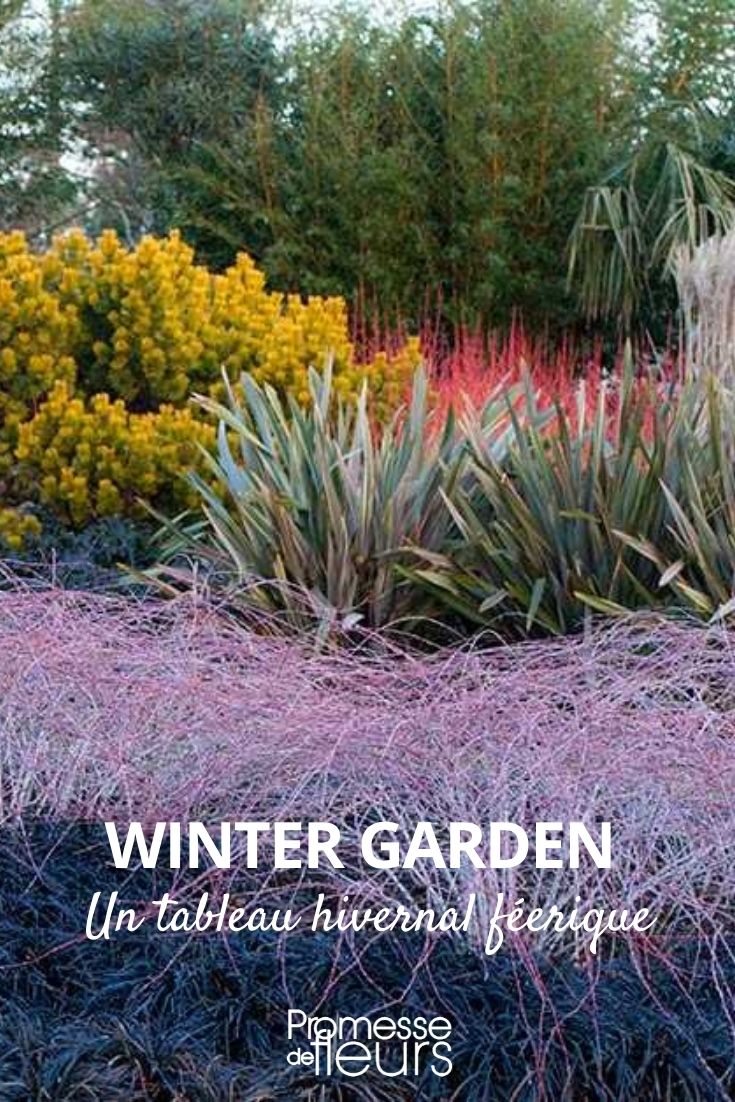































Comments